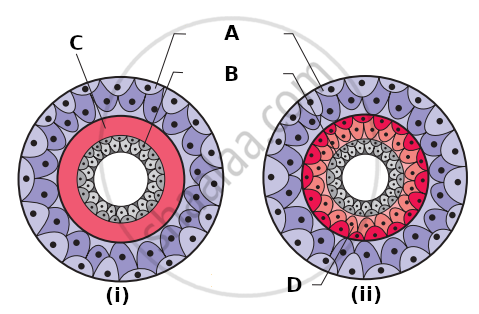Advertisements
Advertisements
Question
Complete the paragraph using proper words:
(Asymmetrical, Paramecium, Equal, imaginary, central, insects, rats, bird, three, unequal)
If body of any animal is cut through ______ axis of body, it may or may not produce two equal halves. Depending upon this property, there are different types of animal bodies. In the case of ______ body, there is no any such imaginary axis of the body through which we can get two equal halves. For example Amoeba, ______ some sponges. In radial symmetry type of body, if imaginary cut passes through central axis but any plane of body, it gives two ______ halves. For example Starfish. In case of this animal, there are five different planes passing through ______ axis of body through which we can get two equal halves. In Bilateral symmetry type of body, there is only one such imaginary axis of body through which we can get two equal halves. For example: ______ fishes, frog, birds, human, etc.
Solution
If body of any animal is cut through imaginary axis of body, it may or may not produce two equal halves. Depending upon this property, there are different types of animal bodies. In the case of asymmetrical body, there is no any such imaginary axis of the body through which we can get two equal halves. For example Amoeba, Paramoecium some sponges. In radial symmetry type of body, if imaginary cut passes through central axis but any plane of body, it gives two equal halves. For example Starfish. In case of this animal, there are five different planes passing through central axis of body through which we can get two equal halves. In Bilateral symmetry type of body, there is only one such imaginary axis of body through which we can get two equal halves. For example: Insects fishes, frog, birds, human, etc.
APPEARS IN
RELATED QUESTIONS
If you are given a specimen, what are the steps that you would follow to classify it?
How useful is the study of the nature of body cavity and coelom in the classification of animals?
Distinguish between intracellular and extracellular digestion.
What are the reasons that you can think of for the arthropods to constitute the largest group of the animal kingdom?
Label the body organization of human in the following figure:

The following characteristics are essential for classification.
The symmetry exhibited in cnidarians is ______.
Which of the following animals has a true coelom?
In Pheretima locomotion occurs with the help of ______.
Lateral line sense organs occur in ______.
Compare Schizocoelom with enterocoelom.
What are flame cells?
______ is a fluid-filled body cavity.
Examine the figures of diploblastic (i) and triploblastic (ii) organization in animals given below and identify the labelled parts A to D.

Match the following list of animals with their level of organisation.
| Division of Labour | Animal |
| Column I | Column II |
| A. Organ level | i. Pheretima |
| B. Cellular aggregate level | ii. Fasciola |
| C. Tissue level | ii. Spongilla |
| D. Organ system level | iv. Obelia |
Choose the correct match showing division of labour with animal example.
Which group of chordates possess sucking and circular mouth without jaws?
Differentiate between open circulatory system and closed circulatory system
Sort out the animals on the basis of their symmetry (radial or bilateral) coelenterates, ctenophores, annelids, arthropods, and echinoderms.
Animal with bilateral symmetry in ______.
